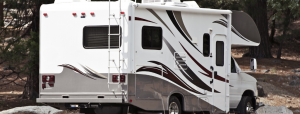Simple. Compact. Small. These are words that don’t typically come to mind when you mention “RV.” Yet, there are lots of RV models that fit this description.
Bigger isn’t always better. Don’t get us wrong, large motorhomes and travel trailers can be fantastic options for the RVer with the goals and lifestyle to match; however, many campers choose to own an RV that is characteristically known as lightweight.
 First, we need to talk about what we mean by a “small” RV.
First, we need to talk about what we mean by a “small” RV.
A small or lightweight RV, when it comes to trailers, is one that can be towed with light-duty trucks, SUVS, crossovers, even vans. They are constructed of lighter weight materials to help keep the towing weight down. Some lightweight RVs can reach close to 40 feet, but they are significantly lighter than other travel trailers of that same size because of the choice of materials.
“Small” can directly mean an RV’s size, too. Teardrop trailers, for instance, are aerodynamically designed to be easier to tow because of its curved roofline. They generally are built to a length of 8-10 feet, and inside you’ll have four to six feet of space. There is some headroom, but if you’re tall, you’ll need to duck a bit for clearance.
When it comes to motorized RVs – your Class A, B, or C – there are smaller models that are under 25 feet. Campervans, Class B motorhomes, in particular are generally shorter, plus you don’t need to tow anything or be towed if you don’t want to. They are the smallest motorhome type, being anywhere from 18-24 feet long. You can find smaller Class C motorhomes, a step up from Class B when it comes to size, camper capacity, and comfort. They can be found in the range of 24-26 feet.
Of course, you can’t mention small or compact RVs without mentioning truck campers and pop-up campers. Truck campers utilize the bed of a pickup truck, while pop-up campers can be folded and unfolded similarly to a tent to give you room to camp. Some pop-up campers can be as lightweight as 850 pounds, but they can be close to 4,000 pounds.
Some of the most appealing aspects of small RVs include the ability to tow without the need to purchase a heavy-duty truck (trailers), the ability to drive pretty much anywhere without fearing many restrictions (motorized), the more affordable price-tag (in most cases), and the more simplistic approach to RVing.
Although many small or lightweight RVs don’t include a bathroom, there are some that do. You can, however, find comfortable sleeping quarters, dining space, sink, stove, and refrigerator in pretty much any model.
 A smaller RV can be ideal for people who are looking to have more flexibility as far as traveling – no need to worry about low bridges or tight streets – and visiting places without the need to use an alternative vehicle. Smaller RVs are easier to tow, simpler to set up at camp, and you can camp practically anywhere. If you can drive there, you can camp there.
A smaller RV can be ideal for people who are looking to have more flexibility as far as traveling – no need to worry about low bridges or tight streets – and visiting places without the need to use an alternative vehicle. Smaller RVs are easier to tow, simpler to set up at camp, and you can camp practically anywhere. If you can drive there, you can camp there.
The lower price tag is also an important factor in exploring the option of owning a smaller RV. Smaller RVs offer luxury and ease in a compact package, and they can accommodate up to six people in many models. For a family of six or fewer, this can be a great choice, especially since kids are busier than ever these days. If you want to give them camping memories but without breaking the bank, then a smaller RV – whether motorized or towable – is the way to go. Likewise for couples or single travelers who just need a sturdy roof over their head and the adaptability to go camping when and where they wish.

